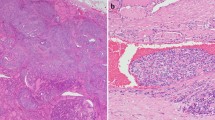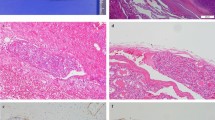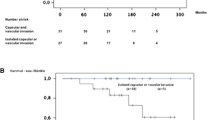Abstract
Background
Encapsulated angioinvasive follicular thyroid carcinoma (EAFTC) is associated with an increased risk of distant metastasis and reduced survival compared to minimally invasive follicular thyroid carcinoma (MIFTC). There is controversy regarding the extent of surgery and adjuvant radioactive iodine therapy for angioinvasive follicular thyroid carcinoma when stratified by number of foci of angioinvasion.
Methods
All follicular thyroid carcinoma cases from 1990–2018 were identified from a thyroid cancer database. Primary outcomes were distant metastasis-free survival (DMFS) and disease-specific survival (DSS) with factors of interest being age, gender, tumour size, treatment, foci of angioinvasion and histological subtype.
Results
A total of 292 cases were identified; 139 MIFTC, 141 EAFTC and 12 widely invasive follicular thyroid carcinoma (WIFTC). Over a follow-up period of 6.25 years, DMFS was significantly reduced (p < 0.001) with 14.2% (EAFTC) and 50% of WIFTC developing metastasis. The risk of metastasis in EAFTC with ≥ 4 foci of angioinvasion was 31.7% (HR = 5.89, p = 0.004), 6.3% for EAFTC with < 4 foci of angioinvasion (HR = 1.74, p = 0.47), compared to 3.6% MIFTC. Age ≥ 50 years (HR = 4.24, p = 0.005) and tumour size (HR = 1.27, p = 0.014) were significantly associated with increased risk of distant metastasis. DSS was reduced significantly (p < 0.001), with 7.8% EAFTC patients dying of disease. For EAFTC patients, DSS was 96.8% for < 4 foci and 82.6% for ≥ 4 foci of angioinvasion (p = 0.003).
Conclusion
EAFTC is at increased risk of distant metastasis related to the extent of angioinvasion. Tumours with < 4 foci of angioinvasion should be considered for a total thyroidectomy, particularly in older patients.


Similar content being viewed by others
Abbreviations
- FTC:
-
Follicular thyroid carcinoma
- EAFTC:
-
Encapsulated angioinvasive follicular thyroid carcinoma
- MIFTC:
-
Minimally invasive follicular thyroid carcinoma
- WIFTC:
-
Widely invasive follicular thyroid carcinoma
- DMFS:
-
Distant metastasis-free survival
- DSS:
-
Disease-specific survival
- RAI:
-
Radioactive iodine
References
Parameswaran R, Shulin HuJ, Min En N et al (2017) Patterns of metastasis in follicular thyroid carcinoma and the difference between early and delayed presentation. Ann R Coll Surg Engl. https://doi.org/10.1308/rcsann.2016.0300
Janovitz T, Barletta JA (2018) Clinically relevant prognostic parameters in differentiated thyroid carcinoma. Endocr Pathol 29:357–364
Nixon IJ, Whitcher MM, Palmer FL et al (2012) The impact of distant metastases at presentation on prognosis in patients with differentiated carcinoma of the thyroid gland. Thyroid. https://doi.org/10.1089/thy.2011.0535
Klöppel G, Couvelard A, Hruban RH et al (2017) WHO classification of tumours of the endocrine organs. WHO Press, Geneve
DeLellis RA, Lloyd Rv, Heitz PU EC (2004) Pathology and genetics of tumours of the endocrine organs. Series: IARC/Word Health Organization Classification of Tumours
O’Neill CJ, Vaughan L, Learoyd DL et al (2011) Management of follicular thyroid carcinoma should be individualised based on degree of capsular and vascular invasion. Eur J Surg Oncol. https://doi.org/10.1016/j.ejso.2010.11.005
Kim HJ, Sung JY, Oh YL et al (2014) Association of vascular invasion with increased mortality in patients with minimally invasive follicular thyroid carcinoma but not widely invasive follicular thyroid carcinoma. Head Neck. https://doi.org/10.1002/hed.23511
Ito Y, Hirokawa M, Masuoka H et al (2013) Prognostic factors of minimally invasive follicular thyroid carcinoma: extensive vascular invasion significantly affects patient prognosis. Endocr J. https://doi.org/10.1507/endocrj.EJ12-0419
Sugino K, Kameyama K, Ito K et al (2012) Outcomes and prognostic factors of 251 patients with minimally invasive follicular thyroid carcinoma. Thyroid. https://doi.org/10.1089/thy.2012.0051
Xu B, Wang L, Tuttle RM et al (2015) Prognostic impact of extent of vascular invasion in low-grade encapsulated follicular cell-derived thyroid carcinomas: a clinicopathologic study of 276 cases. Hum Pathol. https://doi.org/10.1016/j.humpath.2015.08.015
Mete O, Asa SL (2011) Pathological definition and clinical significance of vascular invasion in thyroid carcinomas of follicular epithelial derivation. Mod Pathol. https://doi.org/10.1038/modpathol.2011.119
Ito Y, Hirokawa M, Masuoka H, Higashiyama T, Kihara M, Onoda N, Miya A, Miyauchi A (2022) Prognostic factors for follicular thyroid carcinoma: the importance of vascular invasion. Endocr J Apr 29. https://doi.org/10.1507/endocrj.EJ22-0077. Online ahead of print.
Haugen BR, Alexander EK, Bible KC et al (2016) 2015 American Thyroid Association Management Guidelines for adult patients with thyroid nodules and differentiated thyroid cancer: the American Thyroid Association Guidelines Task Force on Thyroid Nodules and differentiated thyroid cancer. Thyroid. https://doi.org/10.1089/thy.2015.0020
Ito Y, Onoda N, Okamoto T (2020) The revised clinical practice guidelines on the management of thyroid tumors by the japan associations of endocrine surgeons: core questions and recommendations for treatments of thyroid cancer. Endocr J. https://doi.org/10.1507/endocrj.EJ20-0025
Dionigi G, Kraimps JL, Schmid KW et al (2014) Minimally invasive follicular thyroid cancer (MIFTC)—a consensus report of the European Society of Endocrine Surgeons (ESES). Langenbeck’s Arch Surg 399(2):165–184
Dralle H, Musholt TJ, Schabram J et al (2013) German Association of Endocrine Surgeons practice guideline for the surgical management of malignant thyroid tumors. Langenbeck’s Arch Surg 398(3):347–375
Perros P, Boelaert K, Colley S et al (2014) Guidelines for the management of thyroid cancer. Clin Endocrinol (Oxf). https://doi.org/10.1111/cen.12515
Pisanu A, Di Chiara B, Reccia I, Uccheddu A (2010) Oncocytic cell tumors of the thyroid: factors predicting malignancy and influencing prognosis, treatment decisions, and outcomes. World J Surg. https://doi.org/10.1007/s00268-009-0357-z
Stenson G, Nilsson IL, Mu N et al (2016) Minimally invasive follicular thyroid carcinomas: prognostic factors. Endocrine. https://doi.org/10.1007/s12020-016-0876-y
Lee YM, Song DE, Kim TY et al (2016) Risk factors for distant metastasis in patients with minimally invasive follicular thyroid carcinoma. PLoS ONE. https://doi.org/10.1371/journal.pone.0155489
Goldstein NS, Czako P, Neill JS (2000) Metastatic minimally invasive (encapsulated) follicular and Hurthle cell thyroid carcinoma: a study of 34 patients. Mod Pathol. https://doi.org/10.1038/modpathol.3880023
Staubitz JI, Musholt PB, Musholt TJ (2019) The surgical dilemma of primary surgery for follicular thyroid neoplasms. Best Pract Res Clin Endocrinol Metab 33(4):101292
Matsuura D, Yuan A, Wang LY et al (2022) Follicular and Hurthle cell carcinoma: comparison of clinicopathological features and clinical outcomes. Thyroid. https://doi.org/10.1089/thy.2021.0424
Yamazaki H, Katoh R, Sugino K et al (2022) Encapsulated angioinvasive follicular thyroid carcinoma: prognostic impact of the extent of vascular invasion. Ann Surg Oncol. https://doi.org/10.1245/s10434-022-11401-x
Lee YM, Lee YH, Song DE et al (2017) Prognostic impact of further treatments on distant metastasis in patients with minimally invasive follicular thyroid carcinoma: verification using inverse probability of treatment weighting. World J Surg. https://doi.org/10.1007/s00268-016-3608-9
Sugino K, Kameyama K, Nagahama M et al (2014) Does completion thyroidectomy improve the outcome of patients with minimally invasive follicular carcinoma of the thyroid? Ann Surg Oncol. https://doi.org/10.1245/s10434-014-3734-2
Jin M, Kim ES, Kim BH et al (2020) Clinical implication of world health organization classification in patients with follicular thyroid carcinoma in South Korea: a multicenter cohort study. Endocrinol Metab. https://doi.org/10.3803/EnM.2020.742
Mazzaferri EL, Robbins RJ, Spencer CA et al (2003) A consensus report of the role of serum thyroglobulin as a monitoring method for low-risk patients with papillary thyroid carcinoma. J Clin Endocrinol Metabol 88:4508–4509
Whitley RJ, Ain KB (2004) Thyroglobulin: A specific serum marker for the management of thyroid carcinoma. Clin Lab Med 24(1):29–47
Jayasekara J, Jonker P, Lin JF et al (2020) Early postoperative stimulated serum thyroglobulin quantifies risk of recurrence in papillary thyroid cancer. In: Surgery (United States)
Zhao T, Liang J, Li T et al (2017) Serial stimulated thyroglobulin measurements are more specific for detecting distant metastatic differentiated thyroid cancer before radioiodine therapy. Chin J Cancer Res. https://doi.org/10.21147/j.issn.1000-9604.2017.03.07
Liu L, Huang F, Liu B, Huang R (2018) Detection of distant metastasis at the time of ablation in children with differentiated thyroid cancer: The value of pre-ablation stimulated thyroglobulin. J Pediatr Endocrinol Metab. https://doi.org/10.1515/jpem-2018-0075
Santhanam P, Ladenson PW (2019) surveillance for differentiated thyroid cancer recurrence. Endocrinol Metab Clin N Am 48(1):239–252
Ren L, Zhang C, Shen Y et al (2021) The value of stimulated thyroglobulin before the first radioactive iodine treatment in metastasis for differentiated thyroid carcinoma. Clin Lab. https://doi.org/10.7754/Clin.Lab.2020.201032
Kim H, Park SY, Jung J et al (2019) Improved survival after early detection of asymptomatic distant metastasis in patients with thyroid cancer. Sci Rep. https://doi.org/10.1038/s41598-019-55370-w
Durante C, Haddy N, Baudin E et al (2006) Long-term outcome of 444 patients with distant metastases from papillary and follicular thyroid carcinoma: Benefits and limits of radioiodine therapy. J Clin Endocrinol Metab. https://doi.org/10.1210/jc.2005-2838
Kim SY, Kim HJ, Kim S-M et al (2020) Thyroid hormone supplementation therapy for differentiated thyroid cancer after lobectomy: 5 years of follow-up. Front Endocrinol 11:520. https://doi.org/10.3389/fendo.2020.00520
Der LJ, Lin SF, Chen ST et al (2017) Long-term follow-up of papillary and follicular thyroid carcinomas with bone metastasis. PLoS ONE. https://doi.org/10.1371/journal.pone.0173354
Lee Y-M, Jeon MJ, Kim WW et al (2019) Optimal thyrotropin suppression therapy in low-risk thyroid cancer patients after lobectomy. J Clin Med 8:1279. https://doi.org/10.3390/jcm8091279
Funding
Funding in the form of departmental funds was received for data-linkage with the New South Wales registry of births and deaths for survival data.
Author information
Authors and Affiliations
Corresponding author
Ethics declarations
Conflict of interest
The authors declare that there is no conflict of interest
Ethics approval
Ethics approval was obtained from the local hospital ethics committee.
Additional information
Publisher's Note
Springer Nature remains neutral with regard to jurisdictional claims in published maps and institutional affiliations.
Supplementary Information
Below is the link to the electronic supplementary material.
Rights and permissions
About this article
Cite this article
Leong, D., Gill, A.J., Turchini, J. et al. The Prognostic Impact of Extent of Vascular Invasion in Follicular Thyroid Carcinoma. World J Surg 47, 412–420 (2023). https://doi.org/10.1007/s00268-022-06696-6
Accepted:
Published:
Issue Date:
DOI: https://doi.org/10.1007/s00268-022-06696-6




